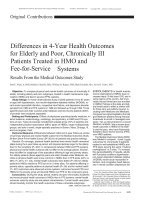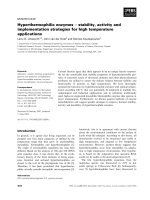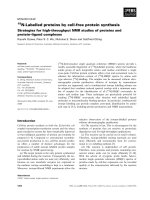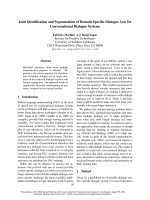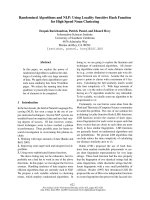Decentralization and regionalization redesigning health systems for high quality maternity care; comment on “decentralization and regionalization of surgical care a review of evidence for the optimal distribution o
Bạn đang xem bản rút gọn của tài liệu. Xem và tải ngay bản đầy đủ của tài liệu tại đây (307.71 KB, 3 trang )
Int J Health Policy Manag 2021, 10(4), 215–217
doi 10.34172/ijhpm.2020.30
Commentary
Decentralization and Regionalization: Redesigning Health
Systems for High Quality Maternity Care
Comment on “Decentralization and Regionalization of Surgical Care: A Review of Evidence
for the Optimal Distribution of Surgical Services in Low- and Middle-Income Countries”
Sanam Roder-DeWan*
ID
Abstract
The question of how to optimally design health systems in low- and middle-income countries (LMICs) for high
quality care and survival requires context-specific evidence on which level of the health system is best positioned
to deliver services. Given documented poor quality of care for surgical conditions in LMICs, evidence to support
intentional health system design is urgently needed. Iverson and colleagues address this very important question.
This commentary explores their findings with particular attention to how they apply to maternity care. Though
surgical maternity care is a common healthcare need, maternal complications are often unpredictable and require
immediate surgical attention in order to avert serious morbidity or mortality. A discussion of decentralization for
maternity services must grapple with this tension and differentiate between facilities that can provide emergency
surgical care and those that can not.
Keywords: Regionalization, Decentralization, Service Delivery Redesign, Health System Quality, Maternal Health
Copyright: © 2021 The Author(s); Published by Kerman University of Medical Sciences. This is an open-access
article distributed under the terms of the Creative Commons Attribution License ( />licenses/by/4.0), which permits unrestricted use, distribution, and reproduction in any medium, provided the
original work is properly cited.
Citation: Roder-DeWan S. Decentralization and regionalization: redesigning health systems for high quality
maternity care: Comment on “Decentralization and regionalization of surgical care: a review of evidence for
the optimal distribution of surgical services in low- and middle-income countries.” Int J Health Policy Manag.
2021;10(4):215–217. doi:10.34172/ijhpm.2020.30
I
verson and colleagues tackle a critically important topic
that remains understudied in low- and middle-income
countries (LMICs): what is the optimal way to organize a
health system to produce good surgical outcomes1? Though the
evidence base for answering this question in LMICs is anemic,
a mounting body of work suggests that improving the quality
of surgical care needs urgent attention.2,3 How one organizes
a health system can impact outcomes across a variety of
conditions; intentional and outcomes-oriented health system
design should be considered a core health reform by countries
struggling with poor quality of care. The Lancet Global Health
Commission on High Quality Health Systems identifies
service delivery redesign as one of four universal actions that
LMICs should consider when strategizing to improve quality.4
Service delivery redesign means restructuring where and by
whom services are delivered to ensure the delivery of highquality care. Conditions that require advanced training, multidisciplinary care teams, and high technological inputs should
ideally be shifted to centralized hospitals, while services that
would benefit from closeness to community, are more chronic
and need many health service contacts should be delivered in
more distal primary care facilities.5 Iverson et al contribute to
the evidence-base for how best to implement service delivery
redesign.
UNICEF, Health Section, Dar es Salaam, Tanzania.
Article History:
Received: 7 December 2019
Accepted: 23 February 2020
ePublished: 3 March 2020
*Correspondence to:
Sanam Roder-DeWan
Email:
Health systems in many LMICs are inherited from an
epidemiological era dominated by communicable diseases.
These systems were designed to deliver episodic care to high
mortality populations, and in many cases, for conditions that
were funded vertically through development partnerships.6
Though we are far from being able to say that communicable
diseases are behind us,7 impressive immunization coverage,
improved public health measures and the successful scaling
of relatively simple treatments for common illnesses (eg, oral
rehydration for childhood diarrhea), have meant that the
health systems of today are left with a different, and more
complex, mix of challenges.
Systems were also designed to maximize access. Global
attention is now turning to the long-neglected role of quality
of care in improving outcomes.8 Accessing services is not
enough to produce good health if those services do not meet
minimum standards of quality.9,10 In a study of mortality due
to poor quality of care, Kruk and colleagues estimated that in
2016, 5 million excess deaths globally were due to poor quality
of care.11 How should health systems change to respond to the
changing burden of disease? Where, and by whom, should
services be delivered to maximize system assets and produce
the best outcomes for people?
In their paper, Decentralization and Regionalization
Roder-DeWan
of Surgical Care: A Review of Evidence for the Optimal
Distribution of Surgical Services in Low- and MiddleIncome Countries, Iverson et al grapple with one of the core
dimensions of service delivery design, regionalization vs.
decentralization.1 Though, as they state, strong evidence
from high-income countries exists and points to the benefits
of regionalization for rare, high-complexity conditions, it
is unclear which conditions are best treated where and by
whom in LMICs. They look specifically at surgical conditions,
including obstetric procedures, through a scoping review of
the literature. They conclude that decentralization, especially
for obstetric procedures, has been successful in the majority
of studies and go on to recommend criteria for selecting the
best health system level for a particular service.
A few key issues should be considered when interpreting
their results, especially as they apply to obstetric care. First, the
authors have excluded natural childbirth from their analysis.
Unlike other surgical conditions where the need for surgery is
often immediately apparent and dictates triage decisions upon
patient presentation, childbirth is an exception. The need
for surgical intervention is often unknown when a pregnant
woman presents to the health system. When surgery is
needed, the need often arises quickly in patients that may have
been considered low-risk initially. For example, studies from
a variety of settings suggest that about one third of women
categorized as low-risk will go on to develop a complication
requiring advanced care.12,13 By excluding studies that look at
vaginal deliveries, it becomes difficult to understand where
obstetric services are best delivered overall.
Another key methodological issue should be considered
when interpreting the the literature. The authors make the
practical decision to use two health system levels to organize
and analyze the literature. The first category – “decentralized”
– includes health centers and district hospitals. The second
category includes regional hospitals and higher. Though
perhaps logical and even clinically sound for the analysis of
many conditions, obstetrics is an exception. Recent evidence
shows that secondary facilities with cesarean section capacity
deliver higher quality intrapartum care than primary care
facilities.14 The important dividing line for obstetrics appears
to be whether or not the facility can deliver high quality
advanced obstetric and neonatal care (ie, comprehensive
emergency obstetric and newborn care), not whether it is above
or below the level of a regional hospital. Decentralizing to a
health facility without functional surgical services or access
to blood products is very different from decentralizing to
a district hospital capable of dealing with an obstetric or
neonatal emergency, but these scenarios are considered jointly
in the Iverson review. Gabrysche and colleagues illustrate this
point nicely in their study of 119 244 pregnancies in Ghana
where they show that access to advanced high-quality care
leads to improved outcomes, not access to any facility for
delivery.15 The categorization decision made by Iverson et
al masks this important distinction and makes their results
difficult to interpret and apply to obstetric system design
efforts in LMICs.
Finally, though the authors do not intend to directly compare
regionalization to decentralization, and indeed do not review
216
studies that do so, the structure of the paper may suggest
that their findings are robust to comparison. In reality, and
as the authors clearly state, each included study compares an
intervention to “business-as-usual.” Unfortunately, businessas-usual at all levels of the health system in LMICS often means
poor quality of care, poor provider performance, system
shortcomings and poor outcomes.4,16 Interventions that bring
resources and attention can often improve processes of care in
the short-run, but sustaining improvements is the perennial
challenge. The question of how to restructure health systems
for optimal outcomes cannot be adequately answered without
understanding the sustainability of proposed changes. The
field sorely needs longitudinal studies that explore structural
improvements to health systems and follow their impact over
longer periods of time.
The authors conclude that three factors should be
considered when deciding where surgical conditions should
be delivered in LMIC health systems: acuity, volume and
complexity. This is a valuable conclusion that countries should
consider when making health system decisions about surgical
services. Volume and quality are closely related. A growing
literature from primarily high-income countries suggests that
higher volume facilities produce better maternal and neonatal
outcomes. In a study of volume and quality of obstetric care
in 5 LMICS, facilities performing over 500 deliveries each
year were better prepared to deliver high quality care.10
Without concentrating services for rare conditions in a
limited set of specialized facilities, providers will not be able
to acquire and maintain the skills necessary to deliver high
quality care. Similarly, centralized facilities with a mix of
specialized providers are more likely to be able to deliver the
interdisciplinary care that is often needed to address complex
conditions. Obstetric fistula surgery is a good example; where
the best outcomes occur in centers that can perform surgical
procedures, and provide “wrap around” care that addresses
the psychological and social needs of women recovering from
obstetric fistula. Acuity is a more complex consideration that
requires high quality services to be closer to where people fall
ill. In general, low volume, low acuity and high complexity
conditions are amenable to regionalization, while high
volume, high acuity, low complexity conditions might best be
decentralized.
Unfortunately, low acuity, low volume and high complexity
conditions do not always occur together. For example, the high
acuity clinical challenge of head trauma requiring surgical
intervention is complex and relatively rare. Though Iverson
et al state that cesarean sections are “low resource and low
complexity,” there is no consensus around this categorization,
and many would argue that, though common (high volume),
obstetrics is highly complex. The same obstetric interventions
that can save lives, when applied in the wrong patient, can lead
to unnecessary complications.17 Additionally, providers must
have the skills to transition quickly from gently supporting
a physiologic process to decisively handling life-threating
pathologies. It is examples such as these where acuity, volume
and complexity fail to run together that will tax health
systems the most to consistently deliver high quality care to
all. Surgical disparities are likely to remain the longest for
International Journal of Health Policy and Management, 2021, 10(4), 215–217
Roder-DeWan
these types of conditions.
The work by Iverson and colleagues is a welcome addition
to the literature on health and quality in LMICs because it
takes the health system as its unit of analysis on quality. This
is relatively rare in the literature on quality of care which is
dominated by studies that look at the “micro” level – studies
that analyze the user interaction with health facilities, the
behaviors of providers or facility operations. An analysis of
the primary care improvement literature estimate that about
three quarters of published studies targeted this micro level.4
Though measurement of quality and efforts to improve quality
are necessary at all levels of the health system, the literature
is incomplete without an understanding of the macro and
meso levels. More importantly, the Lancet Global Health
Commission on High Quality Health Systems argues that
improvement at the meso and macro levels through structural
reforms stand to make the biggest impact in settings that
need big changes to consistently deliver high quality care.4
The study by Iverson et al is the type of analysis needed to
begin informing these structural reforms and moving LMICs
towards high quality health systems.
5.
6.
7.
8.
9.
10.
11.
Ethical issues
Not applicable.
12.
Competing interests
Author declares that she has no competing interests.
13.
Disclaimer
The views expressed in this article are my own and not those of UNICEF.
14.
Author’s contribution
SRD is the single author of the paper.
References
1.
2.
3.
4.
Iverson KR, Svensson E, Sonderman K, et al. Decentralization and
regionalization of surgical care: a review of evidence for the optimal
distribution of surgical services in low- and middle-income countries.
Int J Health Policy Manag. 2019;8(9):521-537. doi:10.15171/
ijhpm.2019.43
Juran S, Broer PN, Klug SJ, et al. Geospatial mapping of access to
timely essential surgery in sub-Saharan Africa. BMJ Glob Health.
2018;3(4):e000875.
doi:10.1136/bmjgh-2018-000875
Meara JG, Leather AJ, Hagander L, et al. Global Surgery 2030:
evidence and solutions for achieving health, welfare, and economic
development. Lancet. 2015;386(9993):569-624. doi:10.1016/s01406736(15)60160-x
Kruk ME, Gage AD, Arsenault C, et al. High-quality health systems
15.
16.
17.
in the Sustainable Development Goals era: time for a revolution.
Lancet Glob Health. 2018;6(11):e1196-e1252. doi:10.1016/s2214109x(18)30386-3
Gage AD, Carnes F, Blossom J, et al. In low- and middle-income
countries, is delivery in high-quality obstetric facilities geographically
feasible? Health Aff (Millwood). 2019;38(9):1576-1584. doi:10.1377/
hlthaff.2018.05397
Bitton A, Ratcliffe HL, Veillard JH, et al. Primary health care as a
foundation for strengthening health systems in low- and middleincome countries. J Gen Intern Med. 2017;32(5):566-571. doi:10.1007/
s11606-016-3898-5
Bygbjerg IC. Double burden of noncommunicable and infectious
diseases in developing countries. Science. 2012;337(6101):14991501.
doi:10.1126/science.1223466
World Health Organization, World Bank Group, OECD. Delivering
Quality Health Services: A Global Imperative for Universal Health
Coverage. Geneva: WHO; 2018.
Souza JP, Gülmezoglu AM, Vogel J, et al. Moving beyond essential
interventions for reduction of maternal mortality (the WHO Multicountry
Survey on Maternal and Newborn Health): a cross-sectional
study. Lancet. 2013;381(9879):1747-1755. doi:10.1016/s01406736(13)60686-8
Leslie HH, Fink G, Nsona H, Kruk ME. Obstetric facility quality and
newborn mortality in Malawi: a cross-sectional study. PLoS Med. 2016;
13(10):e1002151. doi:10.1371/journal.pmed.1002151
Kruk ME, Gage AD, Joseph NT, Danaei G, García-Saisó S, Salomon
JA. Mortality due to low-quality health systems in the universal health
coverage era: a systematic analysis of amenable deaths in 137
countries. Lancet. 2018;392(10160):2203-2212. doi:10.1016/s01406736(18)31668-4
Danilack VA, Nunes AP, Phipps MG. Unexpected complications of lowrisk pregnancies in the United States. Am J Obstet Gynecol. 2015;
212(6):809.e801-806. doi:10.1016/j.ajog.2015.03.038
Aoyama K, D’Souza R, Pinto R, et al. Risk prediction models for
maternal mortality: a systematic review and meta-analysis. PLoS One.
2018;13(12):e0208563. doi:10.1371/journal.pone.0208563
Kruk ME, Leslie HH, Verguet S, Mbaruku GM, Adanu RMK, Langer A.
Quality of basic maternal care functions in health facilities of five African
countries: an analysis of national health system surveys. Lancet Glob
Health. 2016;4(11):e845-e855. doi:10.1016/s2214-109x(16)30180-2
Gabrysch S, Nesbitt RC, Schoeps A, et al. Does facility birth
reduce maternal and perinatal mortality in Brong Ahafo, Ghana?
a secondary analysis using data on 119 244 pregnancies from two
cluster-randomised controlled trials. Lancet Glob Health. 2019;
7(8):e1074-e1087. doi:10.1016/s2214-109x(19)30165-2
Lewis TP, Roder-DeWan S, Malata A, Ndiaye Y, Kruk ME. Clinical
performance among recent graduates in nine low- and middle-income
countries. Trop Med Int Health. 2019;24(5):620-635. doi:10.1111/
tmi.13224
Miller S, Abalos E, Chamillard M, et al. Beyond too little, too late and
too much, too soon: a pathway towards evidence-based, respectful
maternity care worldwide. Lancet. 2016;388(10056):2176-2192.
doi:10.1016/s0140-6736(16)31472-6
International Journal of Health Policy and Management, 2021, 10(4), 215–217
217

